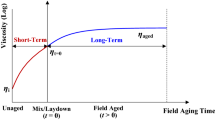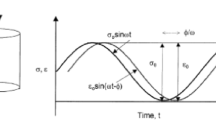Abstract
Prediction of long-term asphalt mixture aging using fundamental characteristics of asphalt binders and mixtures is a complex task. Asphaltene has been reported as one of the major chemical components of asphalt cement binder. Several research studies have established asphaltene content as the fundamental characteristic ingredient present in the asphalt binders required to understand aging-related performance. Dynamic complex modulus (|E*|) is recognized as the paramount performance response parameter for asphalt mixtures, routinely used in pavement design and evaluation exercises. Hence, there is a definitive need to develop mixture aging predictive models using asphaltene content as the fundamental parameter with its effect on the resulting |E*| performance of asphalt mixtures. The objective of this research study was to develop asphalt mixture aging predictive models with asphaltene content as a fundamental performance parameter, using soft computing techniques. Asphalt binders and corresponding asphalt mixtures were subjected to short- and long-term aging conditions. Asphaltene contents and rheological properties were measured for different asphalt binders. Volumetric properties and |E*| were conducted for corresponding asphalt mixtures. Artificial Neural Network (ANN) method was employed to develop a rational model for evaluating asphalt mixture aging behavior considering asphaltene content values from asphalt binders. A total of seven different dense-graded asphalt mixtures with virgin, polymer-, and rubber-modified binders with two different asphalt contents were produced for experimentation purposes. The results showed that the predictive model developed using the ANN approach provided a robust relationship with asphaltene aging indices, a fundamental asphalt property used to quantify asphalt mixture properties at various aging conditions.



Similar content being viewed by others
References
Bell CA (1989) Aging of Asphalt-Aggregate systems, SR-OSU-A-003A-89-2, Summary Report, Strategic highway research program, National Research Council, Washington, DC, USA
Airey GD (2003) State of the art report on ageing test methods for bituminous pavement materials. Int J Pavement Eng 4(3):165–176
Petersen D, Link R, Abbas A, Choi B, Masad E, Papagiannakis T (2002) The influence of laboratory aging method on the rheological properties of asphalt binders. J Test Eval 30(2):171
Branthaver JF, Petersen JC, Robertson RE, Duvall JJ, Kim SS, Harnsberger PM, Mill T, Ensley EK, Barbour FA, Scharbron JF (1993) Binder characterization and evaluation. Volume 2: Chemistry. no. SHRP-A-368
Anderson DA, Christensen DW, Bahia HU, Dongre R, Sharma MG, Antle CE, Button J (1994) Binder characterization and evaluation. Volume 3: physical characterization, Strategic highway research program, National Research Council, Report No. SHRP-A-369
Corbett LW (1969) Composition of asphalt based on generic fractionation, using solvent deasphaltening, elution-adsorption chromatography, and densimetric characterization. Anal Chem 41(4):576–579
Sirin O, Paul DK, Kassem E (2018) State of the art study on aging of asphalt mixtures and use of antioxidant additives. Adv Civil Eng 2018:18. https://doi.org/10.1155/2018/3428961
Morian N, Hajj E, Glover C, Sebaaly P (2011) Oxidative aging of asphalt binders in hot-mix asphalt mixtures. Transp Res Rec J Transp Res Board 2207(2207):107–116
Yin F, Arámbula-Mercado E, Epps Martin A, Newcomb D, Tran N (2017) Long-term ageing of asphalt mixtures. Road Mater Pavement Des 18:2–27
Siddiqui MN, Ali MF (1999) Studies on the aging behavior of the Arabain asphalts. Fuel 78:1005–1015
Michalica P, Kazatchkov IB, Stastna J, Zanzotto L (2008) Relationship between chemical and rheological properties of two asphalts of different origins. Fuel 87(15–16):3247–3253
Kumbargeri YS, Biligiri KP (2016) A novel approach to understanding asphalt binder aging behavior using asphaltene proportion as a performance indicator. J Test Eval Am Soc Test Mater Int 44(1S):1–11. https://doi.org/10.1520/JTE20140490
Kumbargeri YS, Biligiri KP (2016) Understanding aging behaviour of conventional asphalt binders used in India. Transp Res Proc 17:282–290
Lee S-J, Hu J, Kim H, Amirkhanian SN, Jeong K-D (2011) Aging analysis of rubberized asphalt binders and mixes using gel permeation chromatography. Constr Build Mater 25(3):1485–1490
Hofko B, Alavi MZ, Grothe H, Jones D, Harvey J (2017) Repeatability and sensitivity of FTIR ATR spectral analysis methods for bituminous binders. Mater Struct 50(3):187
Hofko B et al (2018) FTIR spectral analysis of bituminous binders: reproducibility and impact of ageing temperature. Mater Struct 51(2):45
Shen J, Amirkhanian SN, Lee S-J (2007) HP-GPC characterization of rejuvenated aged CRM binders. J Mater Civ Eng 19(6):515–522
Wang M, Liu L (2017) Investigation of microscale aging behavior of asphalt binders using atomic force microscopy. Constr Build Mater 135:411–419
Chen A, Liu G, Zhao Y, Li J, Pan Y, Zhou J (2018) Research on the aging and rejuvenation mechanisms of asphalt using atomic force microscopy. Constr Build Mater 167:177–184
Hofko B et al (2016) Impact of maltene and asphaltene fraction on mechanical behavior and microstructure of bitumen. Mater Struct Constr 49(3):829–841
Baek C, Underwood B, Kim Y (2012) Effects of oxidative aging on asphalt mixture properties. Transp Res Rec J Transp Res Board 2296:77–85
Kumbargeri YS, Biligiri KP (2016) Rational performance indicators to evaluate asphalt aging characteristics. J Mater Civ Eng 28(12):1–9
Tavassoti Kheiry P, Boz I, Solaimanian M, Barzegari S (2018) Effect of age hardening on modules of warm mix asphalt mixtures. In: Canadian society for civil engineering, 2018
Boz I, Chen X, Solaimanian M (2017) Assessment of laboratory oven-aging of asphalt concrete mixtures via impact resonance test. In: International conference on advances in construction materials and systems
Witczak M (2008) Specification criteria for simple performance tests for rutting, volume I: dynamic modulus (E*), volume II: flow number and flow time: NCHRP, Report 580
Seitllari A, Lanotte MA, Kutay ME (2019) Calibration of the MEPDG rutting model: issues and consequences on rutting prediction. In: Transportation research board 98th annual meeting, 2019, p 6
Seitllari A, Lanotte MA Kutay ME (2019) Comparison of uniaxial tension-compression fatigue test results with SCB test performance indicators developed for performance-based mix design procedure
Boz I, Tavassoti-Kheiry P, Solaimanian M (2017) The advantages of using impact resonance test in dynamic modulus master curve construction through the abbreviated test protocol. Mater Struct 50:176. https://doi.org/10.1617/s11527-017-1045-3
Kim YR et al (2017) Long-term aging of asphalt mixtures for performance testing and prediction. NCHRP rep. 871, 2017
Kumbargeri YS, Biligiri KP (2016) A novel approach to understanding asphalt binder aging behavior using asphaltene proportion as a performance indicator. J Test Eval Am Soc Test Mater Int 44(1S):1–11
Naser MZ, Seitllari A (2019) Concrete under fire: an assessment through intelligent pattern recognition. Eng Comput. https://doi.org/10.1007/s00366-019-00805-1
Cobaner M (2011) Evapotranspiration estimation by two different neuro-fuzzy inference systems. J Hydrol 398(3–4):292–302
Mansouri I, Kisi O (2015) Prediction of debonding strength for masonry elements retrofitted with FRP composites using neuro fuzzy and neural network approaches. Compos B Eng 70:247–255
Guclu A, Ceylan H (2007) Condition assessment of composite pavement systems using neural-network-based rapid backcalculation algorithms. In: TRB 86th annual meeting compendium of papers CD-ROM, 2007
Ceylan H, Gopalakrishnan K, Guclu A (2007) Advanced approaches to characterizing nonlinear pavement system responses. Transp Res Rec J Transp Res Board 2005(1):86–94
Andrew L, Kim YR, Ranjithan SR (2008) Backcalculation of dynamic modulus from resilient modulus of asphalt concrete with an artificial neural network. Transp Res Rec J Transp Res Board 2057(1):107–113
Xiao F, Amirkhanian S, Juang CH (2009) Prediction of fatigue life of rubberized asphalt concrete mixtures containing reclaimed asphalt pavement using artificial neural networks. J Mater Civ Eng 21(6):253–261
Lytton RL, Tsai FL, Lee SI, Luo R, Hu S, Zhou F (2010) Models for predicting reflection cracking of hot-mix asphalt overlays. NCHRP Report 669, Transportation research board, Transportation Institute of Texas A&M University, College Station, TX
Choi J, Adams TM, Bahia HU (2004) Pavement roughness modeling using back-propagation neural networks. Comput Civ Infrastruct Eng 19(4):295–303
Seitllari A, Kutay ME (2018) Soft computing tools to predict progression of percent embedment of aggregates in chip seals. Transp Res Rec J Transp Res Board 2672(12):32–39
Kisi Ö, Çobaner M (2009) Modeling river stage-discharge relationships using different neural network computing techniques. CLEAN Soil Air Water 37(2):160–169
Seitllari A, Naser MZ (2019) Leveraging artificial intelligence to assess explosive spalling in fire-exposed RC columns. Comput Concr 24(3):271–282. https://doi.org/10.12989/CAC.2019.24.3.271
Seitllari A (2014) Traffic flow simulation by neuro-fuzzy approach. In: Proceedings of second international conference on traffic and transport engineering (ICTTE), 2014, pp 97–102
Boussabaine AH (1996) The use of artificial neural networks in construction management: a review. Constr Manag Econ 14(5):427–436
Mashhadban H, Kutanaei SS, Sayarinejad MA (2016) Prediction and modeling of mechanical properties in fiber reinforced self-compacting concrete using particle swarm optimization algorithm and artificial neural network. Constr Build Mater 119:277–287
Yu Y, Li W, Li J, Nguyen TN (2018) A novel optimised self-learning method for compressive strength prediction of high performance concrete. Constr Build Mater 184:229–247
Alavi AH, Hasni H, Zaabar I, Lajnef N (2017) A new approach for modeling of flow number of asphalt mixtures. Arch Civ Mech Eng 17(2):326–335
Sollazzo G, Fwa TF, Bosurgi G (2017) An ANN model to correlate roughness and structural performance in asphalt pavements. Constr Build Mater 134:684–693
Ozturk HI, Kutay ME (2014) An artificial neural network model for virtual Superpave asphalt mixture design. Int J Pavement Eng 15(2):151–162
Sebaaly H, Varma S, Maina JW (2018) Optimizing asphalt mix design process using artificial neural network and genetic algorithm. Constr Build Mater 168:660–670
Zhang H, Fu X, Jiang H, Liu X, Lv L (2015) The relationships between asphalt ageing in lab and field based on the neural network. Road Mater Pavement Des 16(2):493–504
Haykin S (1994) Neural networks: a comprehensive foundation, 1st edn. Prentice Hall, Hamilton
Bro R, Smilde A (2014) Principal component analysis. Anal Methods 6(9):2812
Author information
Authors and Affiliations
Corresponding author
Ethics declarations
Conflict of interest
The authors declare that they have no conflict of interest.
Additional information
Publisher's Note
Springer Nature remains neutral with regard to jurisdictional claims in published maps and institutional affiliations.
Rights and permissions
About this article
Cite this article
Seitllari, A., Kumbargeri, Y.S., Biligiri, K.P. et al. A soft computing approach to predict and evaluate asphalt mixture aging characteristics using asphaltene as a performance indicator. Mater Struct 52, 100 (2019). https://doi.org/10.1617/s11527-019-1402-5
Received:
Accepted:
Published:
DOI: https://doi.org/10.1617/s11527-019-1402-5




